Licence to ride
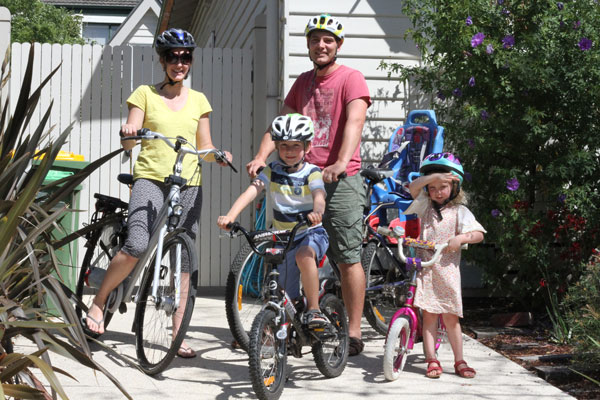
Politicians, media pundits and commentators have all argued in favour of it—but should bicycles have number plates? Simon Vincett takes an in-depth look at bicycle registration.
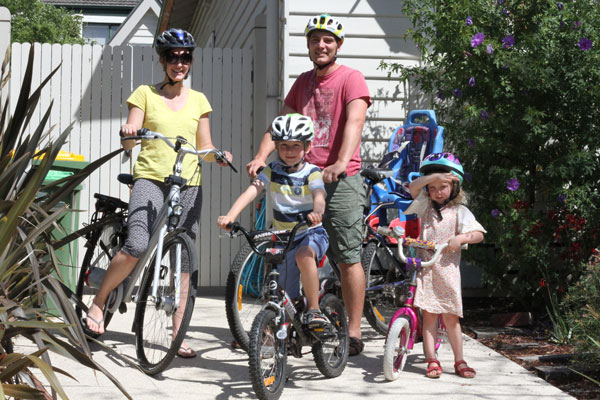
Maarten, Tracey and their two kids live within riding distance from work, school and childcare. Shared paths and separated bike lanes aren’t bad in their inner-Melbourne region and home suburb of Thornbury—compared to most parts of Australia, that is—but the majority of Maarten and Tracey’s riding is on the road. With their kids, who are six and four-years-old, they use pedal power to get around.
One of the best parts of riding a bike, apart from the health benefits it brings, is the fact that it’s relatively cheap.
But, if politicians in both Melbourne and Sydney had their way, Maarten and Tracey—and all bike riders—would have to register their bikes and obtain a licence to ride on the road. For Maarten’s family, this could mean registration of four bikes, at a cost of $25 to $100 each, plus four licences, at a cost of $25 to $100 each, introducing a new cost to the family of between $200 and $800 per year.
“I would probably only register my commuter bike and the other one I would probably shy away from,” Maarten explains. “It’s not much, $25, but for a bike I only use on the weekends I probably wouldn’t spend the money. For Tracey, it would be the same—register one and not the other.”
Maarten admits the cost of bike registration could be a considerable burden on the family—especially the children.
“With our kids’ bikes, it would depend on the cut-off. As they grow you upsize their bikes, so I don’t know how that system would work. If you’re registering kids’ bikes that’s an expensive process.” Public debate about bike registration ignited in May (2014) when Bayside Council’s Mayor Laurence Evans proposed registration to address conflict on Melbourne’s Beach Road between riders and drivers, while that same month in Sydney a spate of serious and fatal collisions prompted the NSW Roads Minister, Duncan Gay, to announce that he was looking at whether bicycles should be registered.
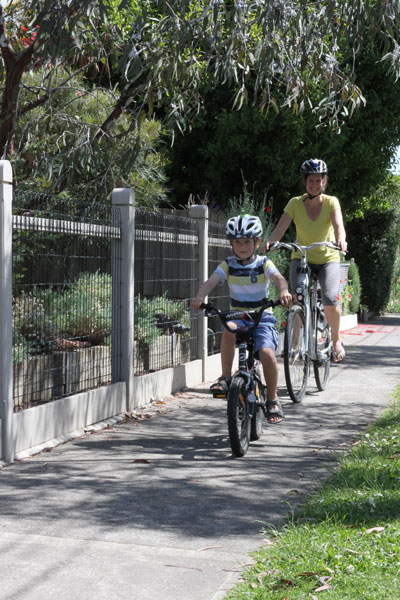
Calls for bike registration by Mayor Evans and Minister Gay have not been clear in the extent and the cost of the scheme but NSW Government briefing documents, obtained through Freedom of Information, explore the viability of a scheme. The most feasible option is that it would mirror the motor vehicle scheme and include both annual registration of bikes and up-to-date licences for riders. These would be compulsory only for those riding on the road.
Children can ride on the footpath accompanied by an adult in Australia. This right ends in Victoria, New South Wales, Western Australia and South Australia when children are 12 years old, after which they must ride on the road. In other states and territories bike riders of all ages can use the footpath, unless signs forbid access.
Tracey rides with her daughter to childcare on the footpath before continuing her commute on road. However, on recreational trips the family ride together on the road on occasion, depending on the situation.
“Our kids ride with us now on the road,” explains Maarten, “and I expect I’ll be confident for them to independently ride on the road at about 12.”
That freedom to choose road or footpath, depending on conditions and ease of travel, would be curtailed by a requirement to register any road-going bike and license any road-going rider. Families would need to choose whether that freedom is worth the expense of licences and registration for their children and their bikes.
More formality about children riding on the road, however, shows up a related legal difficulty that children under 15 years old can’t be prosecuted for traffic offences under the existing legal system. This is just one example of the difficulty of establishing a bike registration scheme, and the jury is out on whether it is at all worthwhile at all.
In terms of precedent, a look around the world shows that registration of bicycles and/or licensing of bike riders is not currently operating anywhere, though it has been tried and repealed in a few places, such as Switzerland.
Bicycle Network, the peak body for bike riding in Australia, is opposed to bike registration, seeing it as a serious impediment to people getting physically active by riding a bike. Bicycle Network CEO Craig Richards wrote in May 2014 in the Sydney Morning Herald, “Bike riding is the best way to stop … preventable tragedy linked to inactivity. That’s because you don’t need to find extra time in your day. You can use a bike to get to work, school or just about anywhere and make it an easy part of your life. Adding expensive registration fees would simply mean people stop riding because they wouldn’t want to pay.”
“This issue has floated around for some time but never gained traction because governments know, like we do, that the concept doesn’t stack up.” Bicycle Network
For Bayside Mayor, Laurence Evans, bike registration promised accountability for what he conceived as poorly behaved cyclists. For NSW Roads Minister Gay, bikes should be banned from certain roads “for their own safety”, and bike registration seemed a tool to control unsafe riding. These reactions are typical of calls for bike registration to address “the problem of cyclists”. More comprehensively, the “problem of cyclists” is generally conceived as basically three-fold:
1 Bike riders disobey the road rules.
2 Bike riders “don’t pay their way”.
3 Bike riders are periodically killed and seriously injured by motor vehicles and they must be protected for their own safety.
How bike registration can solve these issues, partially or at all, is generally not spelled out clearly or comprehensively, but arguments are made in an attempt to address real or perceived issues. So, while it’s easy to argue that developing and implementing a new scheme of bike registration is a lot of trouble with minimal chance to raise useable revenue, it is necessary to look at the motivation behind registration of bikes to find solutions to the real conflict between motorists and bike riders the current traffic system.
Disobeying road rules
Unfortunately a proportion of all road users flaunt the rules. Police blitzes, such as Operation Halo by Victoria Police, usually catch more motorists infringing the rules than bike riders, even in the cycling hotspot of Beach Road, Melbourne.
Findings like this prompt commentators such as Michael O’Reilly, columnist for the Sydney Morning Herald, to ask, “Is a massive, costly logistical exercise, registering the one million bicycles sold in Australia every year, really worth it to maybe catch a few cyclists who treat red lights as give way signs?”
It would seem that number plates don’t prevent traffic infringements from happening. Motorists with number plates also disobey the road rules and being identifiable doesn’t stop them.
As many motorbike riders have noted—it is notoriously difficult to fit visible number plates to motorbikes, but bicycles are even more of a challenge in this regard. If the intention is to aid identification by traffic cameras, this scheme needs a serious cost–benefit analysis because traffic cameras exist only in a fraction of locations where road rules can be broken.
Also to consider in a cost–benefit analysis is the burden of enforcement. The NSW Department of Roads in a briefing document about bike registration pointed out that “it is likely that additional government resources would be needed to enforce a bicycle registration scheme. NSW Police would be required to devote personnel to enforcing the display of number plates.”
One of the side benefits of bike registration that has been suggested is that it would assist in the case of bike theft. But, as the NSW Department of Roads points out, “Bicycles are easily dismantled and have parts that are generally interchangeable and lack identifying numbers (like a Vehicle Identification Number or engine number). Unfortunately this would make it virtually impossible to trace a particular bicycle through a registration system to ensure safety and compliance.”
Thornbury rider Maarten suggests a solution many experienced bike riders would be familiar with: “I grew up in Holland and typically there you get identification engraved in the frame. The little license plate at the back, I doubt that would have any benefit at all, but the engraving in the frame is something you can organise yourself. If you remember your frame number it’s a self-registering system: if your bike is stolen you go to the police and tell them ‘This is the ID of my bike’.”
Paying their way
A frequent objection to bike riders on the road is that they don’t pay for the privilege. The assumption is that motor vehicle registration pays for road building and maintenance, however, this is not true. Roads are predominantly paid for from federal taxes and council rates (in the case of local roads). Motor vehicle registration is used up in administration and third-party insurance, not to build our next super highway.
The truth is that roads are paid for by all tax payers, whether they are drivers or bike riders, or even if they only walk. A registration scheme for bikes that also raised revenue for bike infrastructure would, therefore, be at odds with the motor vehicle registration system, as well as prohibitively expensive for bike riders.
While we all pay for roads, we don’t all pay the same—and we don’t all have a choice—says transport planner and commentator, Alan Davies. Writing in 2013 in Crikey’s The Urbanist blog, Davies points out, “I don’t think the claim that motorists pay for roads can be dismissed out of hand. The fuel excise is $0.38 per litre. That’s about $627 p.a. for the average car. While that’s general revenue, drivers are clearly taxed in their role as motorists and there’s no doubt the fuel excise moderates the demand for driving.”
“It is not the public’s fault that the alternatives to driving are so poorly developed in Australia” Alan Davies
This is not to say that the revenue raised is well used, however, Davies goes on to say. “By buying petrol and registering cars people are not necessarily revealing a preference for road transport. There’s a substantial captive market of people who are forced to buy petrol and pay fuel tax and car registration despite wanting an alternative. They may prefer that the revenue be spent on public transport … It is not the public’s fault that the alternatives to driving are so poorly developed in Australia.”
Third-party insurance is a key way in which motor vehicle registration is thought to be paying cars’ way. But third-party insurance is compulsory for motor vehicles because they have such potential for causing serious damage to property and injury to people. This is not the case with bicycles and, in fact, is more relevant to the rider than with the bike being ridden.
City of Sydney councillor, Christine Forster, has suggested a one-off fee at the time of bike purchase to cover third-party insurance. In October 2013 she proposed in Sydney’s Daily Telegraph “a system under which a one-off registration and third party insurance fee is paid at the point of sale for each adult-sized bicycle in NSW.”
Canvassing this suggestion and other pros and cons of compulsory insurance, the NSW Department of Roads in 2013 advised that “cover against damage caused to third parties in an accident involving a bicycle can be provided by personal liability insurers”.
While insurance is covered, the significant legal implications of bike registration are raising alarm bells for governments. The NSW Department of Roads warned in a 2013 position paper that “introduction of a bicycle registration scheme would require a major shift in public policy and significant changes to registration, accident and insurance law.”
This is a sizeable and expensive undertaking for any state or territory to bring to bear in its own jurisdiction but, to be viable, a scheme of bike registration should exist in all states and territories with reasonable consistency, comparable to that for motor vehicles. This would require further effort to coordinate and would also have to deal with inconsistencies in traffic regulations for bike riders between states and territories.
The conclusion of the NSW Department of Roads 2013 position statement was: “It is not likely that a compulsory bicycle registration scheme would be a cost-effective way of improving NSW cyclists’ behaviour or safety.”
Providing ‘safety’
However, it was in the name of safety that NSW Roads Minister Gay proposed bike registration, a link that had at least one commentator “stumped”.
Bicycle Network General Manager of Government and External Relations Chris Carpenter sees restriction of bike riding through the obligation of registration as a misguided move.
“Governments across Australia need to find solutions to tackling our nation’s health challenges such as heart disease, diabetes, stroke, and depression,” Carpenter points out. “It is essential that Australians increase their level of physical activity to combat these challenges. Introducing a cost barrier to bike riding goes against this notion of physical activity.”
Agreement with this is no further away than within Minister Gay’s own department, which argues in its October 2013 position paper that, “Many multi-bike families would be disadvantaged in meeting registration fees and infrequent riders may also be dissuaded from using a bicycle, which would not promote the environmental and health policy objectives of the government.”
“Policy makers work tirelessly to get people more active and adding a cost and administrative burden in the way of this goal makes no sense,” Mr Carpenter says. “This issue has floated around for some time but never gained traction because governments know, like we do, that the concept doesn’t stack up.”
“a bicycle registration scheme would have considerable impact on the community without being able to deliver the outcomes frequently claimed for such an initiative” Queensland Parliamentary Inquiry into Cycling
In 2013, the Queensland government considered registration for bicycles as part of its “Inquiry into Cycling”. The Parliamentary Committee conducting the inquiry rejected the concept in its Recommendation 34, stating, “It is considered that the introduction of a bicycle registration scheme would have considerable impact on the community without being able to deliver the outcomes frequently claimed for such an initiative”.
Its report goes on to outline the detriment of hampering ease of bike riding, saying, “Cycling is valued for the important contribution it makes to the development of a sustainable and effective transport system. It also has significant benefits for health, the environment and tourism, as well as positive local impacts in connecting communities. It is an important form of exercising as well as being used for commuting.”
The Queensland government has accepted the Inquiry’s recommendation 34 and has dismissed bicycle registration as a useful initiative.
As regular bike riders and parents of riding kids, Maarten and Tracey see a strong need for education about bikes, for riders and for motorists.
“I remember when I was in primary school we learnt to ride as part of the school curriculum. It was not so much the technical skills as the road rules and knowing your position on the road. I think that’s a good thing to do,” says Maarten.
Tracey sees the need for something similar in Australia. “Like you have a swimming program, you can have a bike riding program. If you can instil in young people now that these are their responsibilities and this is how it works, then by the time they get their licence they’ve already thought about how bikes and cars share the road. It starts to change how people feel about bikes.”
Gaining your driver’s licence is another opportunity for education about bikes and cars sharing the road, Tracey suggests. “As part of getting your licence you need to understand about bikes more. It’s not just about the road rules for you as a driver; it’s about how you deal with pedestrians, how you deal with bikes. Part of having a driver’s licence should be understanding what [other road users] are allowed to do, where they can ride on the road. At the end of the day, you’re in a car—if you hit a bike, the bike is going to come off worse.”
In Australia’s current traffic environment, Maarten frequently sees confusion about bikes in traffic, both from drivers and from riders. “You see cyclists do both things and as a driver you just don’t know where to go, and who’s in the right and who’s in the wrong,” he says.
Hand-in-hand with education goes improved policing to direct road users about sharing the road and enforce the existing road regulations. Police blitzes such as Operation Halo by Victoria Police in Melbourne are an example. Maarten is also in favour of increased policing.
“It sounds bad,” he explains, “but people don’t realise the context that they are in. I’m not necessarily about fining—it’s about educating people.”
What would it cost?
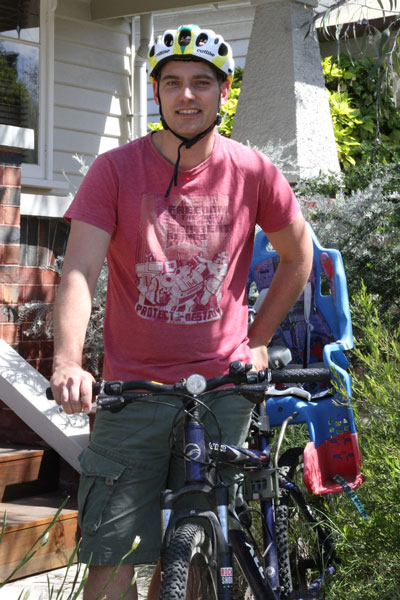
A bike registration and/or rider licensing scheme has never been costed by any government in Australia. However, the Road Traffic Authority (now Transport for NSW) stated in 2011 that $20 is the minimum fee for car registration to cover administrative cost. This amount raises no revenue to recover costs of infrastructure nor does it provide third-party insurance. But if bike riders are to put some money towards “paying their way”, at least $5 must be added per registration to cover this. However, some sources suggest bike registration might need to be as much as $100 per bike.
What about third-party insurance? For bike riders, particularly with multiple bikes, this seems most viably covered in licensing the rider. With $20 as a base fee to cover administration, the scheme would then have to collect at least $5 by way of third-party insurance premium. This makes an annual licensing fee of $25, though the renewal period could presumably be every 10 years as it is for motor vehicles. Some sources suggest that bike licence may cost as much as $100 per annum.
Ride On content is editorially independent, but is supported financially by members of Bicycle Network. If you enjoy our articles and want to support the future publication of high-quality content, please consider helping out by becoming a member.



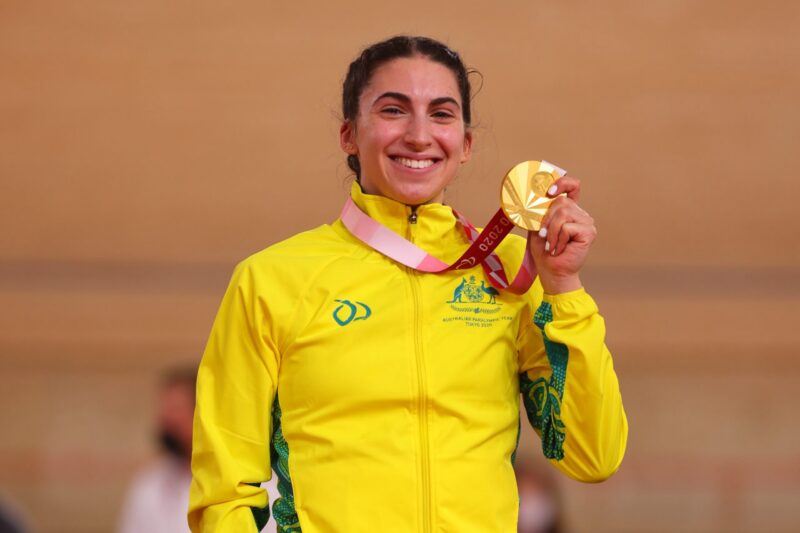
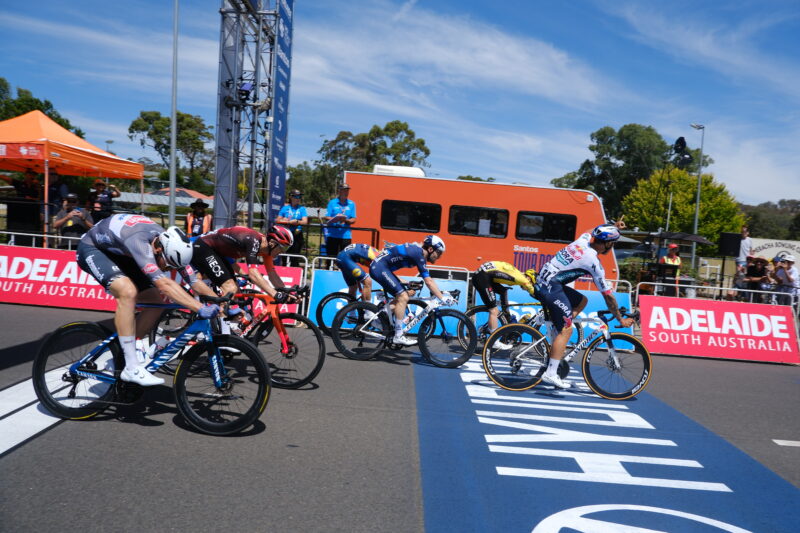
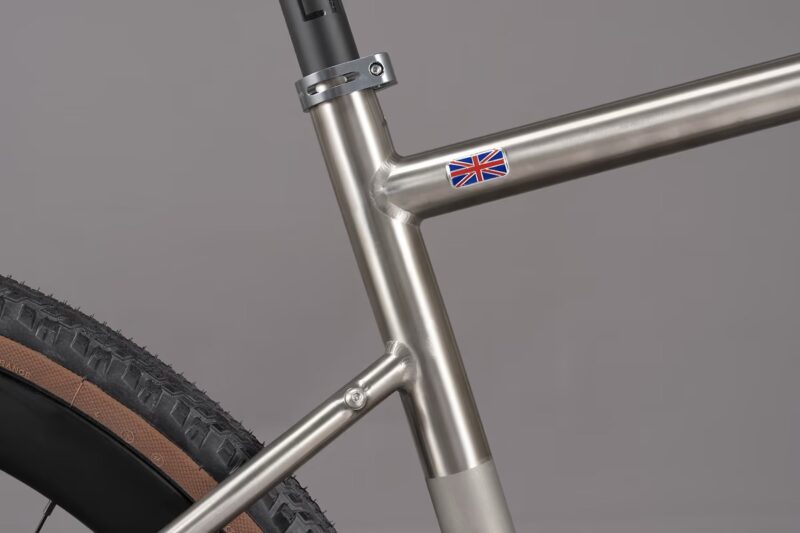


Registration is the bogey that has haunted Australian politics for 120 years – even before there were cars on the road! For the historic context see the edifying clips here: https://australian-cyclists-party.org/latest-media-release/rego-history/
Previous registration attempts all failed here as they have nearly everywhere else in the world. The evidence is so compelling it is being totally ignored.
If they government were truly trying to encourage cycling, they would focus on making it more rather than less appealing. In fact they should instead propose a registration scheme not aimed at enforcement but rather one that tracked and paid cyclists $1.40/km – the net benefit the Federal Government has calculated cyclists deliver to the health and transport budgets!
Why I support bike rego . . Is simply because I am sick of seeing recreational riders intimidated by pack riders and run off the bike paths. This would enable the easy identification of these bullies and hopefully prosecution.
Legislation may help to change the tactics used by the packs ( bike thugs) and educate them into respecting the families and retirees who have the same rights to using the bike paths and who cycle for enjoyment and fitness.
Maybe their governments might like to limit tge size of group riders who use bike paths as an additional change to any legislation.
next we’ll get a tax on shoes
I’m a bike rider and I also drive a car (shock!). I’m sure there’s more than a few of us in this boat that already “pay our way”. Introducing additional bike registration/licence fees would surely mean that motorists who don’t ride bikes are the bludgers, sponging off the rest of us.
Let me get this straight… I pay for registration and a licence for my bike. I have the same rights as cars (like I do now anyway). I will now ride in the middle of the lane on main roads in peak hour at 20kph with my pack of buddies to work. We’ll lane split like motor bikes and then take a whole lane when cars start moving. Will drivers feel happier now I have a licence? I’m paying for my share of the road!
As road users on bicycles we can use the whole lane now. What is often overlooked is most cyclists’ efforts to enhance traffic flow by cycling as close to the kerb as possible.
Yes can’t wait to get my Rego. I already have a licence from CA. Imagine we could ride 1 rider in each lane side by side on the Monash Freeway at 30kph. When the cars & trucks start tooting we can just point to our rego plates.
Its a joke!! Bicycling is one of the last true freedoms we have. That’s why we love it!@ We never got over it from our youth. If more people rode bikes there would be less car drivers complaining about cyclist’s. I am a motorcyclist aswell, and I am appalled every day (I average 55000km’s/yr) at how badly people drive. They only drive in front of themselves, not aware of what is ahead even 100 metres. Its just another revenue raiser that could never be properly policed…..
There needs to be more thought and discussion about how to make rogue cyclist accountable not discussion about the health benefits of cycling.
More and more cyclist and cars have ‘dash’ cameras catching the offenders so a simple number plate on the back of the bike or on the helmut could go a long way to nailing the cyclist that goes through a red light or rides illegally.
Regards,
Kevin
Just so long as you are willing for this to work every which way all of the time; i.e. not just when it suits one to report, so when you run a red light or are speeding and have evidence to that effect, you should be lodging said evidence in order to have yourself prosecuted for breaking the law…
A Danish tourist recently hit the news when he said Australia was the worst country to cycle in. That we are even having a “debate” about bike registration just goes to prove his point.
Just a correction. Adults are permitted to ride on the footpath in SA if accompanying a child. It’s actually a pretty good commonsense rule that was recently adopted.
I support displaying drivers licence numbers on all vehicles. In Queensland large numbers of drivers are unlicenced and there is a huge trade in points transferral. Using colour coded plates attached by velcro, magnets or brackets would be no more onerous than putting on P plates and would ensure camera captured offences go to the right people and cyclists along with all other road users would be identifiable.
Most adult bike riders also drive cars. Thus they are licenced for on the road. They already pay car insurance, but while on the bike the car is off the road. I am a member of my State Bike Association which gives insurance cover as part of membership. I have 3 bikes plus a car, only one can be on the road at one time.
I pay 9 sets of registration with my cars, motor bikes, boats and their trailers.
I feel they when I leave all the other vehicles at home and ride the bike I have already paid to use the road.
I would be prepared to buy a number plate like the exempt trailer number plates that show my cars rego and put that on my bike.
Its great to see this detailed discussion and range of opinions quoted here – but HERE is not where it needs to be – out THERE in the wider community is where it needs to be. The health, economic and community benefits from cycling need to be outlined to the general public – for ex: less traffic, less pollution, lower costs, obvious health benefits – that’s a no-brainer – more parking, speedier travel for others – in a country that, apart possibly from Tasmania, one can cycle in all year round? It’s not rocket science!
Actually, you can cycle all year round in Tasmania too. I have been doing this for years with no trouble.
car driving is more dangerous than cycling. I would like to see an analysis of the need for car drivers and passengers to wear helmets
The problem and solutions:
From the Freecycle Facebook page, https://fbcdn-sphotos-h-a.akamaihd.net/hphotos-ak-xap1/v/t1.0-9/1509813_628062770636529_468836252810135924_n.jpg?oh=d0d7e0a925fa74ce705cfab79a752c7e&oe=550DBDC2&__gda__=1427628351_789e3ebcfbc3279dae94784f4335cf94
http://www.copenhagenize.com/2011/02/australian-call-for-motoring-helmets.html
Great to see NSW representing all of Australia again. As for registration – the majority of bike uses do pay registration and fuel tax etc. cos most of us own a car
Facts:-
1. Monash Uni study showed 87% of all bicycle/motor vehicle incidents were the cars fault
3. Pschologist study found that the greatest cause of road rage was impatience by motor vehicles (bikes held them up)
2. Road deaths and trauma (and think of massive related costs) are caused by motor vehicles not bicycles
3. Damage to roads not caused by bicycles
4. Percentage wise, motor vehicles break more road rules than cyclists
5. Irresponsible media commentators support motor vehicles aggression to cyclists with statements “lycra lunatics” (Neil Mitchell) and “Jihad on Cyclists” (Miranda Devine, Herald Sun)
And that’s just off the top of my head!
I agree with Colin, we need to be more vocal in our defense.
One proposal based upon the various historical videos of the Dutch and other experiences.
From kindergarten onwards road rules are included in organised play for school children.
Prior to age twelve school children are taught and tested for bicycle use. A certificate of cycling competency to be issued.
All new applicants for motor vehicle licences must produce a certificate of cycling competency. These can be gained through approved courses as offered by local CARES facilities or the like.
Minimum disruption to existing licencing and registration, requires only on box on an application to be ticked and certificate sighted – maximum direct and effective application of education and resources.
Bike registration is an old chestnut for the bicycle-phobic oz drivers. Would a reg. on my back would make riding safer with rogue drivers in their urban tanks who love to shave me by 20cm? I’ve got my doubts. Coming from Europe I never experienced such an animosity toward cyclists.
Forget rego for bicycles, that’s a joke, remove ridiculous wearing of helmets as well. Cyclists should receive financial incentives to ride, that would make more sense.
As a PT-user, cyclist, driver and pedestrian, I support having a way to identify cyclists on the move. Everyone have entitlement issues and none of you can claim being always zen towards all other category of commuters and then all road courtesies goes out the window.
I’ve got videos of motorcyclists racing on freeways, drivers going through red lights, what I’m missing is a way to identify cylists who can’t afford losing any momentum by stopping at a red light or as a tram stops.
A small correction but in Western Australia there is no mention in the Western Australian Road Traffic Code 2000 that adults can ride on footpaths when accompanying children under 12 years of age. Children under 12 can ride on the footpath, but their parents or accompany adult(s) cannot it seems.
This has been a personal gripe with me ever since I became serious about cycling.
I’m a truck/car driver, PT user and cyclist. I do everything by the book and and ride in a traffic friendly fashion. I’m also sick of being tarred with the same brush and abused by drivers because of all the drongos on bikes as my cycling mentor calls them.
I ride with a helmetcam and sadly I’ve recorded just as many stupid inconsiderate cyclists as stupid inconsiderate drivers.
I think some kind of regulation should be considered. For instance, how many who regularly ride bikes actually gone to the VicRoads website and read the ‘Regulations for Cyclists. At the very least bicycle sellers could be made to supply a copy of the regulations with each new bike sold.
This would gain cyclists greater recnigition from other road users and strengthen our calls for infrastructure improvements.
I have been a motorist, a cyclist and a motorist again. In my opinion the majority of cyclists fall into one or both of two categories – the arrogant and the ignorant. Unlike cyclists, motorists are bound by the law – they may not race or practice racing on roads that are not closed to the public. They may not drive two abreast (or more) so that they can chat to their fellow drivers. They may not wilfully and dangerously impede other road users. And, of course, they must observe speed limits and traffic signals.
All of the above is considered disdainfully optional by the majority of cyclists.
Which is why they are hated with such passion.
Everybody pays to provide bike lanes and the buggers refuse to use them – ‘everyone has a right to the road’.
Everyone has a right, everyone has a responsibility – cyclists are getting a free ride !
Seems to be a hot topic. With all the things I see on the road bike riders are no different to motorists, some obey the law, some dont. If they had a rego plate they could be reported however they dont and therefore its very difficult to report a ‘guy in a red cycling suit’ when you see them run red lights or do something dangerous. I think if the rider not the bike was registered and you can wear your rego on your person or bike you could take that rego to any bike and only pay one fee. Also I think it should not require a license just a registration as a cyclist so you are accountable for your actions when on your bike. This could be a 5 yearly deal maybe costing the $25 suggested which equets $5 a year – about the cost of a coffee. Any way that mny 2c’s.